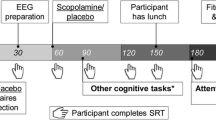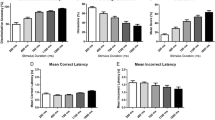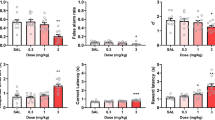Abstract
In the present study, the effects of scopolamine (SCOP) were determined upon the performance of rats in the five-choice serial reaction time task, a test of attention analogous to the continuous performance test in man. Rats were trained to detect and respond to brief flashes of light presented randomly in one of five locations until a stable level of performance was reached. SCOP (0.03–0.1 mg/kg SC) was administered 30 min prior to testing under standard conditions of stimulus presentation. SCOP reduced response accuracy at the highest dose and dose-dependently increased omissions and perseverative responses. However, these effects were mimicked by scopolamine methylbromide (SCOPMBr) which might suggest a peripheral site of action. When the task difficulty was increased by manipulating the stimulus presentation parameters, i.e. reduced stimulus intensity, duration or temporal predictability, SCOP (0.075 mg/kg SC) failed further to impair performance accuracy. However, in two separate experiments, SCOP (0.075 mg/kg SC) robustly increased the distractibility caused by a burst of loud white-noise occurring unpredictably during the intertrial-interval: SCOP significantly decreased accuracy and increased omissions, magazine latency, premature and perseverative responses compared with vehicle and the equivalent dose of SCOPMBr. These findings provide further evidence of a role for the central cholinergic system in attention.
Similar content being viewed by others
References
Callahan MJ, Kinsora JJ, Harbaugh RE, Reeder TM, Davis RE (1993) Continuous ICV infusion of scopolamine impairs attention of rhesus monkeys. Neurobiol Aging 14:147–151
Capatani E, Della Sala S, Lucchelli F, Soave P, Spinnler H (1988) Perceptual attention in ageing and dementia measured by Gottschaldt's hidden figure test. J Gerontol 6:157–163
Carli M, Robbins TW Evenden JL, Everitt BJ (1983) Effects of lesions to ascending noradrenergic neurons on performance on a 5-choice serial reaction time task in rats: implications for theories of dorsal noradrenergic bundle function based on selective attention and arousal. Behav Brain Res 9:361–380
Cole BJ, Robbins TW (1989) Effects of 6-hydroxydopamine lesions of the nucleus accumbens septi on performance of a 5-choice serial reaction time task in rats: implications for theories of selective attention and arousal. Behav Brain Res 33:165–179
Craik FIM, Byrd M, (1982) Aging and cognitive deficits. The role of attentional resources. In: Craik FIM, Trehub, S (eds) Aging and cognitive processes. Plenum Press, New York, pp 191–211
Craik FIM, Simon E (1980) Age differences in memory. The roles of attention and depth processing. In: Poon LW, Fozard JL, Cermak LS, Arenberg D, Thompson LW (eds) New directions in memory and aging. Erlbaum, Hillsdale, New Jersey, pp 95–111
Drachman DA, Sahakian BJ (1980) Memory, aging and pharmacosystems. In: Stein D (ed) The psychobiology of aging: problems and perspectives. Elsevier, North Holland, Amsterdam, pp 347–368
Drachman DA, Noffsinger D, Sahakian BJ, Kurdziel S, Fleming P (1980) Aging, memory and the cholinergic system: a study of dichotic listening. Neurobiol Aging 1:39–43
Dunne MP, Hartley LR (1985). The effects of scopolamine upon verbal memory: evidence for an attentional hypothesis. Acta Psychol 58:205–217
Freed DM, Corkin S, Growden JH, Nissen M (1989) Selective attention in Alzheimer's disease: characterizing cognitive subgroups of patients. Neuropsychologia 27:325–339
Grady CL, Grimes AM, Patronas N, Sunderland T, Foster NL, Rapoport SI (1989) Divided attention, as measured by dichotic speech performance, in dementia of the Alzheimer type. Arch Neurol 46:317–320
Jakala P, Sirvio J, Jolkkonen J, Riekkinen Jr P, Acsady L, Riekkinen P (1992) The effects ofp-chlorophenylalanine-induced serotonin synthesis inhibition and muscarinic blockade on the performance of rats in a 5-choice serial reaction time task. Behav Brain Res 51:29–40
Jones DNC, Barnes JC, Kirkby DL, Higgins GA (1993) Behavioural and pharmacological performance disruption in a 5-choice serial reaction time task in rats. J Psychopharmacol Brit Assoc Psychopharmacology Meeting suppl A82
Kirkby DL, Jones DNC, Higgins GA (1994) Hemicholinium-3 and cognition J Psychopharmacol Brit Assoc Psychopharmacology Meeting suppl A13
McGaughy J, Turchi J, Sarter M (1994) Crossmodal divided attention in rats: effects of chlordiazepoxide and scopolamine. Psychopharmacology 115:213–220
Mishkin M, (1964) Perseveration of central sets after frontal lesions in monkeys. In: Warren JM, Akert K (eds) The frontalgranular cortex and behavior. McGraw-Hill, New York, pp 219–241
Moore H, Dudchenko P, Bruno JP, Sarter M (1992a) Toward modeling age-related changes of attentional abilities in rats: simple and choice reaction time tasks and vigilance. Neurobiol Aging 13[6]:759–772
Moore H, Dudchenko P, Comer KS, Bruno JP, Sarter M (1992b) Central versus peripheral effects of muscarinic antagonists: the limitations of quarternary ammonium derivatives. Psychopharmacology 108:241–243
Muir JL, Dunnett SB, Robbins TW, Everitt BJ (1992a) Attentional functions of the forebrain cholinergic system: effects of intraventricular hemicholinium, physostigmine, basal forebrain lesions and intracortical grafts on a multiple-choice serial reaction time task. Exp Brain Res 89:611–622
Muir JL, Robbins TW, Everitt BJ (1992b) Disruptive effects of muscimol infused into the basal forebrain on conditional discrimination and visual attention: differential interactions with cholinergic mechanisms. Psychopharmacology 107:541–550
Muir JL, Robbins TW, Everitt BJ (1994) AMPA-induced excitotoxic lesions of the basal forebrain: a significant role for the cortical cholinergic system in attentional function. J Neurosci 14 [4]:2313–2326
Parasuraman R, Haxby JV (1993) Attention and brain function in Alzheimer's disease: a review. Neuropsychology 7:242–272
Parasuraman R, Martin A (1994) Cognition in Alzheimer's disease: disorders of attention and semantic knowledge. Curr Opin Neurobiol 4:237–244
Parasuraman R, Greenwood PM, Haxby JV, Grady CL (1992) Visuospatial attention in dementia of the Alzheimer type. Brain 115:711–733
Pribram KH (1961) A further experimental analysis of the behavioural deficits that follows injury to the primate frontal cortex. Exp Neurol 3:432–466
Richardson RT, DeLong MR (1988) A reappraisal of the functions of the nucleus basalis of Meynert. Trends Neurosci 11:264–267
Robbins TW, Everitt BJ, Marston HM, Wilkinson J, Jones GH, Page KJ (1989) Comparative effects of ibotenic acid- and quisqualic acid-induced lesions of the substantia innominata on attentional function in the rat: further implications for the role of the cholinergic neurons of the nucleus basalis in cognitive processes. Behav Brain Res 35:221–240
Rusted JM, Warburton DM (1989) Cognitive models and cholinergic drugs. Neuropsychobiology 21:31–36
Sarter M (1994) Neuronal mechanisms of the attentional dysfunctions in senile dementia and schizophrenia: two sides of the same coin? Psychopharmacology 114:539–550
Wesnes K, Revell A (1984) The separate and combined effects of scopolamine and nicotine on human information processing. Psychopharmacology 84:5–11
Wesnes K, Warburton DM (1983) Effects of scopolamine on stimulus sensitivity and response bias in a visual vigilance task. Neuropsychobiology 9:154–157
Author information
Authors and Affiliations
Rights and permissions
About this article
Cite this article
Jones, D.N.C., Higgins, G.A. Effect of scopolamine on visual attention in rats. Psychopharmacology 120, 142–149 (1995). https://doi.org/10.1007/BF02246186
Received:
Revised:
Issue Date:
DOI: https://doi.org/10.1007/BF02246186




